Sporocarp (fungi)
In fungi, the sporocarp (also known as fruiting body, fruit body or fruitbody) is a multicellular structure on which spore-producing structures, such as basidia or asci, are born. The fruitbody is part of the sexual phase of a fungal life cycle, while the rest of the life cycle is characterized by vegetative mycelial growth and asexual spore production.

The sporocarp of a basidiomycete is known as a basidiocarp or basidiome, while the fruitbody of an ascomycete is known as an ascocarp. Many shapes and morphologies are found in both basidiocarps and ascocarps; these features play an important role in the identification and taxonomy of fungi.
Fruitbodies are termed epigeous if they grow on the ground, like those of ordinary mushrooms, while others which grow underground are hypogeous. Epigeous sporocarps that are visible to the naked eye, especially fruitbodies of a more or less agaricoid morphology, are often referred to as mushrooms, while hypogeous fungi are usually called truffles or false truffles. During their evolution, truffles lost the ability to disperse their spores by air currents, and propagate instead by animal consumption and subsequent defecation.
In amateur mushroom hunting, and to a large degree in academic mycology as well, identification of higher fungi is based on the features of the sporocarp.
The largest known fruitbody is a specimen of Phellinus ellipsoideus (formerly Fomitiporia ellipsoidea) found on Hainan. It measures up to 1,085 centimetres (427 in) in length and is estimated to weigh between 400 and 500 kilograms (880 and 1,100 lb).[1][2]
References
- Cui, B.-K.; Dai, Y.-C. (2011). "Fomitiporia ellipsoidea has the largest fruitbody among the fungi". Fungal Biology. 115 (9): 813–814. doi:10.1016/j.funbio.2011.06.008. PMID 21872178.
- Walker, M. (1 August 2011). "Giant fungus discovered in China". BBC. Archived from the original on 2012-11-29. Retrieved 2020-05-03.
Further reading
- Zabowski, D.; Zasoski, R. J.; Littke, W.; Ammirati, J. (1990). "Metal content of fungal sporocarps from urban, rural, and sludge-treated sites". Journal of Environmental Quality. 19 (3): 372–377. doi:10.2134/jeq1990.00472425001900030004x.